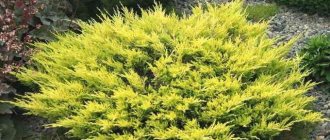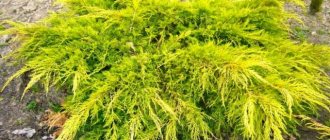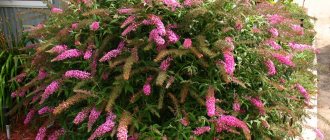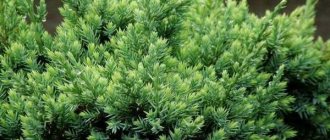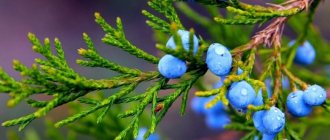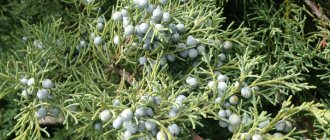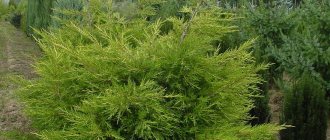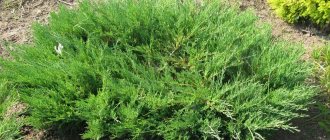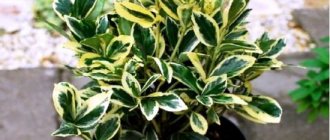17542
Juniper is an attractive plant to grow on site; it easily adapts to unfavorable conditions and saturates the air with a pine aroma. If you want to acquire additional specimens for planting, you can germinate juniper from seeds at home. This method of propagation is not the most popular, but with due effort it becomes possible to grow many strong seedlings. The secret of success is stratification, planting in nutritious soil. Experiments can be carried out in open ground and at home.
Description of creeping juniper
Bushy type plant. The height is 10-40 cm, and the diameter can reach 2-2.5 m. The branches grow and spread along the ground. There is no foliage. Each branch is covered with short needles or scales. The color of the needles is pale green.
This group includes horizontal and creeping junipers. This type is used to create decorative slopes, low borders, and growing in hanging pots. The creeping shrub can easily adapt to any soil in which it is planted, even in rocky areas.
Description of the plant
This type of juniper is also called “creeping”, “prostrate”, “ground cover”, “horizontal”.
The branches of the plant spread along the ground, creating a continuous carpet, which is a valuable property for landscape design.
The bushes reach a height of 10 to 50 cm, and a width of up to 1-2 m. The shape of the crown can be cushion-shaped, round or spreading.
The branches are covered with needles - scales or needles. The length of the needles is usually 2-5 mm. The color comes in various shades of green, gold, silver and blue.
The fruits are round cones, most often dark blue in color with a bluish coating. The root system is superficial and well branched.
Growing regions
This species is highly resistant to cold. All varieties are suitable for cultivation in central Russia (Black Earth, Central, North-Western and Volga regions).
Many frost-resistant varieties thrive in Siberia and the Urals. In the southern regions, it is recommended to shade young plants from sunburn.
Types of creeping juniper
There are 60 known crops that belong to creeping junipers, examples are shown in the photo below. Outwardly they are all similar. Creeping shrubs are united by a low trunk size. The structure of the needles, color, and size may differ.
Andorra Compacta
The bush is densely branched. The maximum height of the bush is 40 cm, width – 2 m. The color of the shoots is brown-green. The bark is brown. The surface of young branches is smooth, while older ones have cracks. The type of needles is scaly or needle-shaped. Its structure is soft and pleasant to the touch. The needles are not wide and tightly pressed to the branches. Creeping juniper is green in summer and turns purple in winter.
Blue Chip
In 1945, the Danes developed a creeping variety. Skeletal shoots are rare. The shape of the bush resembles a five-pointed star. The ends of the branches tend vertically upward. This form of juniper has a raised middle. The needles are mostly needle-shaped, sometimes scaly. The color is grayish blue. There are thorns on the shoots. This ground-blooded shrub reacts negatively to excess moisture. Planting in sunny areas is recommended.
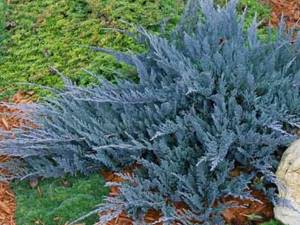
Limeglow
Creeping juniper with yellow needles. The bush is compact. The shape of the crown resembles a vase. The needles are feathery. The color changes throughout the season, becoming orange in winter. It grows slowly. The fruits are rare. The variety does not tolerate excessively wet soil. Photophilous. Frost-resistant. The shrub is resistant to diseases and pests.

Prince of Wales
Combining the top layers with the bottom layers gives a deep green color. The height of the creeping shrub is 30 cm, diameter is 2.5 m. The plant is characterized by slow growth. The form is creeping. The bark is red-gray. The needles are scaly, thick, rich green in color. Reacts calmly to frost and sudden temperature changes. They are mainly planted in open areas for greater decorative effect.
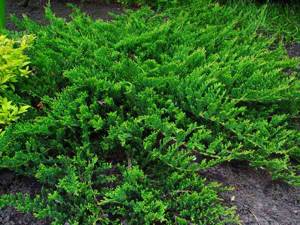
Applications of Juniper
Green berries of Juniper are used to make natural golden-yellow paints. Black - for the production of brown and black paint.
Juniper fruits are not edible and are used as one of the ingredients in the food industry in the manufacture of sweets, baked goods, fruit drinks, and gingerbreads.
Dried juniper is an excellent material for woodworkers and carvers. The wood is perfectly dried and will never crack. Without large resin passages, the wood is easily stained and polished. Having a high density, this material allows you to apply fine threads.
Valuable resin is extracted from Juniper, which is used to make high-quality natural white varnish.
Veres wood is widely used for making pencils.
Creeping juniper in landscape design
In landscape design, creeping juniper is included in decorative single plantings or acts as an integral part in group compositions. Evergreen shrubs look elegant against the background of snow. Low-growing varieties are planted on rocky hills, rock gardens, to stabilize the slopes. Creeping plants grow within 3-4 years, visually creating the appearance of a green carpet.
Creeping juniper combines beautifully with conifers. Various shades and textures are appreciated by designers of street compositions.
Collection and preparation of juniper
Cone berries and juniper needles are used as medicinal raw materials. Cone berries are harvested in the fall from the end of August to the end of October during the period of full ripening, when they turn blue-black. They have a bountiful harvest every 3-4 years. When collecting cones, spread a cloth or paper under the tree and lightly shake the branches so that only ripe berries fall.
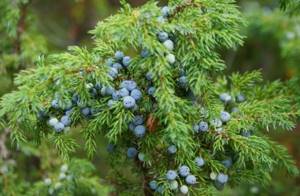
Dry under a canopy or in an attic with good ventilation, but not in dryers and ovens, since such drying destroys biologically active substances. Store in a dry, ventilated area. Properly dried fruits have the correct rounded shape, black color and retain the delicate aroma of juniper.
Planting and caring for creeping juniper
Garden crops require standard care. It takes root quickly. Hardy. Grows easily in city conditions. Varieties of creeping juniper give a small increase per year, about 5-7 cm. In an environment with optimal conditions, the evergreen shrub has a life expectancy of 600 years.
Preparation of seedlings and planting area
It is preferable to buy creeping juniper planting material in containers (see the photo). Then landing is possible at any time. Creeping bushes at the age of 2-3 years are suitable for planting in open ground. The young plant should not show signs of rot or fungal diseases. Roots that are in a closed form adapt faster to space and grow. If there are dry or damaged shoots, they should be trimmed. Trim the side branches and the top to ½ the length of the growth.
The choice of soil depends on the variety of creeping juniper. Basically, the shrub grows well in sandy, loamy, alkaline soils. Prefers a large predominance of peat in the soil. Heavy soils are not suitable for cultivation.
For rapid growth and rapid development, you can use a substrate: coniferous soil, peat, sand. All components will be required in equal proportions. The depressions are prepared 23 days in advance or on the day of planting.
How to plant creeping juniper
Creeping juniper is usually planted in spring or mid-autumn. When planting a plant in another period, slow development and poor survival are observed. In order not to damage the rhizome in the process, the creeping bush is planted with a lump of earth.
- Dig a hole. The dimensions of the hole should be 2-3 times larger than the root system.
- The depth is provided for at least 70 cm.
- Drainage made of gravel or crushed stone is laid at the bottom. Layer thickness 15-20 cm.
- A creeping juniper sapling is placed in the center of the recess and sprinkled with earth.
- Water generously.
- Carry out mulching around the trunk circle.
When planting creeping shrubs, you should keep your distance. The distance between creeping bushes should be at least 1 m. Otherwise, one plant will overlap another, creating shadow.
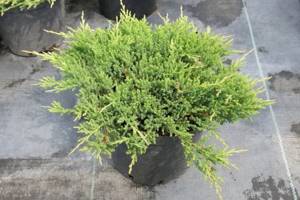
Transfer
When choosing a good site for a coniferous shrub, you should keep in mind that an adult garden plant does not tolerate a change of location. Therefore, creeping juniper is planted on the most successful site, in the gardener’s opinion. Otherwise, the plant will begin to hurt, stop growing for a long time, and yellowing may occur on some branches. A transplanted creeping bush may not survive the winter and wither away.
Attention! The principle of transplanting creeping juniper is similar to the planting process.
Watering and fertilizing
Young growth is watered regularly, but not abundantly. During periods of prolonged absence of rain, water the bush once every 7 days. Creeping juniper is a drought-resistant plant, so water procedures are carried out three times a month. In hot weather, the procedure is performed early in the morning or in the evening. The bushes are also sprayed.
Fertilize creeping juniper in the spring season. Use nitroammophoska in the amount of 20 g per 1 sq. m. It is possible to use other complex preparations for feeding conifers. In September, the fast-growing creeping juniper bush is fed with fertilizers containing phosphorus and potassium.
Mulching and loosening
The tree trunk circle should be regularly cleared of weeds. Mulching will help solve this problem. The procedure helps retain moisture in the soil. Natural material for mulch: pine chips, pine needles, gravel. They will have to be laid on black geotextiles. Minimum layer 5 cm.
After watering, a dense crust forms on the ground, which does not allow the root system of the creeping plant to “breathe.” The loosening procedure is necessary to saturate the soil with oxygen and eliminate weeds. Use a hoe to lift the top layer of soil shallowly so as not to harm the roots.
Preparing creeping juniper for winter
For the winter, cover with creeping junipers that are no more than 4 years old. They choose burlap and spruce branches for this. In cold climates, overgrown bushes are also protected from frost by tying them with twine. This will strengthen the crown and prevent it from breaking under the weight of snow.
Features of planting creeping junipers
Planting and further caring for juniper does not present any particular difficulties if the main preferences of a perennial crop are taken into account.
- A place for planting juniper must be chosen that is sunny, open, and at the same time protected from drafts and gusty winds. In the shade (along walls, solid fences or under trees), the perennial loses its original decorative effect. Light partial shade is allowed. It is important to initially choose the right place to plant conifers, since an adult plant does not tolerate transplantation to a new place very well.
- The time for planting seedlings is spring (April-May) or autumn (October). Seedlings in a container can be planted at any warm time of the year, providing slight shading and regular moisture.
- Junipers are unpretentious conifers that easily take root on any type of soil (sandy, loamy), even rocky. The best option is a mixture of earth, peat and sand, taken in equal proportions.
- Before planting, the site is prepared: it is dug up, fertilized, and weeds are removed.
- At the planned location, a deep planting hole is prepared, equal to 2-3 times the length of the shovel pin. The width of the hole should also be spacious so that the roots of the seedling do not break. The distance between plants is left in accordance with the future size of the crown (from 1 to 3 m) depending on the variety. If the bushes are planted too close, their crowns will begin to overlap each other as they age, creating shade and interfering with the normal growth of the perennial.
- At the bottom of the hole, drainage (10-15 cm) of crushed stone or broken brick is laid, then a layer of soil mixture (in a slide). A seedling is placed on a moistened mound of earth, the roots are straightened and the remaining soil is added. In the case of a closed root system, the earthen ball is completely preserved and transferred to the planting hole, supplemented as necessary with prepared soil substrate.
- After planting, the conifer tree trunk circle is watered and mulched with large wood chips, peat or sawdust. Mulch will help retain moisture and prevent weed growth.
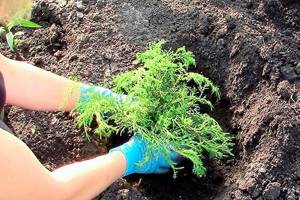
Pruning creeping juniper
Pruning is a mandatory method of caring for juniper, which also has a decorative function.
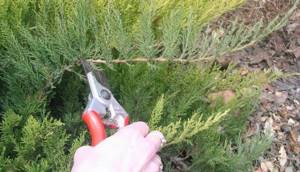
Is it possible to prune creeping juniper?
It is possible and even necessary to prune creeping juniper. If you do not trim the bush, then in the 3rd year after planting the crown will grow and the bush will take on an unkempt appearance. The timing of the procedure is not strict. The best time will be April and September. The plant loves pruning, so it can be done throughout the year, with the exception of the period of active growth. It is also not recommended to prune shoots in frosty weather.
Trim the creeping low-growing juniper twice a year or as needed. There are 2 types of pruning. Sanitary cutting - removal of dry, damaged, frozen shoots. Thus, monitor the density of the bush. The second type is formative pruning. It is carried out at the discretion of the gardener; if the natural form of an evergreen creeping crop is not suitable, then the juniper is given different geometric shapes.
How to prune creeping juniper
Shrub pruning algorithm:
- Bare branches, not covered with green needles and without dormant buds, are removed completely from the stem.
- In one procedure, you cannot trim more than 1/3 of all greenery. Otherwise, slow-growing creeping junipers will have a difficult time recovering.
- Wood cuts should not be made crosswise, as they take longer to heal and do not look aesthetically pleasing.
- Garden cutting tools must be sharp and disinfected.
- Most varieties of creeping junipers contain toxic substances. To protect your hands while pruning, you should use gloves.
- Open cuts on bushes are treated with garden varnish.
- To make the crown thicker, you need to cut off 1/3 of the current year's growth.
- At the end of the procedure, creeping varieties are fed with useful substances and also treated with a fungicide solution.
Reproduction

We take cuttings and propagate ourselves
Most often, ground cover junipers are propagated vegetatively.
Cuttings are carried out in the spring, cutting off branches with a “heel” 10 cm long and deepening them into a nutrient substrate (pre-soaked in Kornevin).
The cuttings are placed in a greenhouse, regularly ventilated and watered. It will take 2-3 months to root them, after which transplantation into open ground is possible.
Reproduction by layering is also popular. This method takes more time, but causes much less trouble: a branch on the parent bush is bent to the ground and simply secured with wire.
First, the area of the shoot is cleared of leaves, a small incision is made and sprinkled with a root formation stimulator.
Roots appear on the branch within a year, after which it can be trimmed and the bush can be replanted.
How to propagate creeping juniper
The propagation process is possible in 3 ways: layering, seeds and cuttings. The first two methods are used extremely rarely, especially the seed method. Only breeders can grow an evergreen creeping shrub from seed, because seedlings are expected to appear three years after planting.
The main method of propagation of creeping juniper is cuttings. Parts of the shoots are cut from a bush that is at least 8-10 years old. The length of the cutting is 10-15 cm. The needles are removed from the shoot 5 cm from the cut, but the bark must be left. For rapid root formation, a branch of creeping juniper is dipped into a stimulating solution for 30 minutes. Then the cuttings are planted at a slight slope into the ground. Cover with plastic wrap and place in a dark place. It is important to observe the following microclimate parameters:
- temperature + 19-20 °C;
- moderate substrate humidity;
- constant spraying with warm water;
- diffuse lighting.
After 30-45 days, roots appear. At the age of two or three years, creeping juniper can be planted in the ground.
How and when to plant
To plant the crop, it is necessary to use young seedlings that were grown in containers. Then they will begin to grow faster. To transplant an adult juniper, skill and experience are required. They grow the plant in the ground, then dig it up and put it up for sale with a lump of earth wrapped in burlap.
Boarding time
It is best to plant the crop in April-May or October. You can purchase seedlings with their roots already closed. Then they can be planted at any time. Only then is it necessary to create certain conditions for them: regular watering and slight shade. It is also worth learning more about juniper Andorra Compact, for this you should read the description.
Soil preparation
To plant creeping juniper, you must choose a consecrated and open place. If you plant the plant in the shade or near a wall with climbing crops, the bush will not fulfill its decorative function. In addition, it will lose its beauty and sophistication. It will appear with limp branches affected by various diseases.
The type of soil depends on the type and variety of plant. If we talk about creeping juniper, it is not picky about the soil and grows on sandy, calcareous soil and even on loam. But there are some varieties that require special conditions to grow.
It is best to use a substrate of peat, coniferous soil and sand for planting juniper. Take these components in equal quantities. Then you have to mulch the ground around the trunk. To do this, you need to use peat and wood shavings from coniferous trees.
To plant a seedling, you need to dig a hole 3 spatula pins deep. Then lower the seedling and cover it with soil. After planting, water the plant right to the roots. If you plant several seedlings, then you must maintain a distance of at least 1 m between them. But how Blue Chip juniper is planted is described in great detail in this article.
Video: horizontal juniper bush in nature
In the video - creeping juniper in nature:
Reproduction options and how to plant
Creeping juniper propagates by seeds, cuttings and offsets. It is propagation by cuttings that allows for high survival rates. Cuttings of the crop are allowed all year round, but it is best to do it in the spring.
It is not recommended to plant cuttings in potatoes, as is done when growing roses. First, you need to root the plant in a greenhouse, and then plant it in a bed under a film. In winter, seedlings are grown in a greenhouse. Before planting, cut cuttings must be kept in water or wet burlap.
The optimal conditions for excellent survival are:
- The temperature should be 16-19 degrees.
- Moist soil and regular spraying.
- Scattered light.
When growing cuttings, it is necessary to take into account this feature: creeping fathoms must be rooted at an angle.
Reproduction by layering in creeping juniper can only occur during the growing season. The shrub bears fruit 2-3 years after planting. On females, dark blue fruits are formed. But seedlings form 1-3 years after sowing the seeds. To increase germination, planting material must be cleaned and placed in sulfuric acid. Keep there for 30 minutes and then rinse.
But what fast-growing hedge plants look like in the photo can be seen in this article.
What fast-growing trees look like and what their names are is described in great detail in this article.
It will also be interesting to see what a willow hedge looks like, for this you should follow the link and look at the photo: https://2gazon.ru/postroiki/zabory/zhivaya-izgorod/krasivaya-iva.html
Maybe
Diseases and pests of creeping juniper
If you carry out preventive care for creeping juniper, then the likelihood of infection by infectious diseases is low. Meanwhile, the evergreen shrub is afraid of gray mold and fungal rust. You can cope with such ailments with systemic fungicides.
Harmful insects are rarely found on creeping juniper. However, you can protect the plant from aphids, scale insects or spider mites using insecticides: “Aktara”, “Aktellik”. If the treatment is carried out in a timely manner, the bush can be saved from complete infection.
Juniper horizontal or prostrate (Juniperus horizontalis) ↑
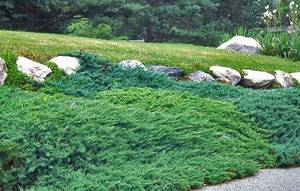
- This is a creeping evergreen shrub from 30 cm to 1 m in height with long branches that are densely covered with bluish-green tetrahedral shoots.
- Crown width from 1.5 m to 2 m.
- The needles are green or gray.
- The leaves are scaly and needle-shaped.
- Undemanding to soil composition, does not tolerate dry air. It has taken root in the southern and middle zones.
If you are interested in this shrub, then look at what different varieties look like in the photo in our other article.
